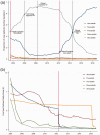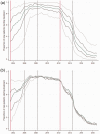Price versus clinical guidelines in primary care statin prescribing: a retrospective cohort study and cost simulation model
- PMID: 34793261
- PMCID: PMC8981530
- DOI: 10.1177/01410768211051713
Price versus clinical guidelines in primary care statin prescribing: a retrospective cohort study and cost simulation model
Abstract
Objective: To investigate the relative impact of generic entry and National Institute for Health and Care Excellence clinical guidelines on prescribing using statins as an exemplar.
Design: Retrospective analysis of statin prescribing in primary care and cost simulation model.
Setting: Royal College of General Practitioners Research and Surveillance Centre (RCGP R&SC) database and Prescription Cost Analysis (PCA) database.
Participants: New patients prescribed statins for the first time between July 2003 and September 2018.
Main outcome measures: Shares of new patients prescribed one of the five statins available in the British National Formulary, and cost of prescribing statins to new and existing patients in primary care in England.
Results: General trends of statin' prescriptions were largely driven by a decrease in acquisition costs triggered by patent expiration, preceding NICE guidelines which themselves did not seem to affect prescription trends. Significant heterogeneity is observed in the prescription of the most cost-effective statin acrossGPs. A cost simulation shows that, between 2004 and 2018, the NHS could have saved £2.8bn (around 40% of the £6.3bn spent on statins during this time) if all GP practices had prescribed only the most cost-effective treatment.
Conclusions: There is potential for large savings for the NHS if new and, whenever possible, ongoing patients are promptly switched to the first medicine that becomes available as generic within a therapeutic class as long as it has similar efficacy to still-patented medicines.
Keywords: clinical guidelines; patent expiration; prescribing behaviour; statins.
Figures



References
-
- World Health Organization. Global Spending on Health: A World in Transition. See https://apps.who.int/iris/handle/10665/330357 (last checked 13 April 2021).
-
- Dall TM, Gallo PD, Chakrabarti R, West T, Semilla AP, Storm MV. An aging population and growing disease burden will require a large and specialized health care workforce by 2025. Health Aff (Millwood) 2013; 32: 2013–2020. - PubMed
-
- Mason A. New medicines in primary care: a review of influences on general practitioner prescribing. J Clin Pharm Ther 2008; 33: 1–10. - PubMed
-
- Harrison S, Dowswell G, Wright J, Russell I. General practitioners’ uptake of clinical practice guidelines: a qualitative study. J Health Serv Res Policy 2003; 8: 149–153. - PubMed
MeSH terms
Substances
LinkOut - more resources
Full Text Sources
Medical

